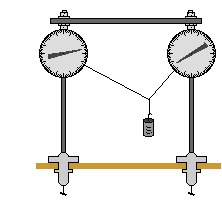Energy comes in many different forms.
The two main forms of energy are KINETIC ENERGY and POTENTIAL ENERGY.
KINETIC ENERGY: ENERGY OF MOTION.
We know that there is kinetic energy when the matter is moving. The faster an object moves, the more kinetic energy it has.
- THERMAL or HEAT ENERGY: ENERGY THAT MAKES OBJECTS HOT.
It is a form of kinetic energy at the molecular level.
It is caused by the increase in activity or velocity of molecules in a substance, which causes the temperature to rise.
| Example: When we boil water in a kettle, we are increasing the kinetic energy of every particle of water. The collective kinetic energy of all these particles is thermal energy. |
POTENTIAL ENERGY: STORED ENERGY.
Due to its position, an object can store energy which is called potential energy.
- GRAVITIONAL POTENTIAL ENERGY: STORED ENERGY IN OBJECT DUE TO ITS HEIGHT WHERE THE FORCE OF GRAVITY CAN ACT ON IT TO MAKE IT FALL.
This type of energy depends on the mass and the height.
There is a direct relation between gravitational potential energy and the mass of an object. More massive objects have greater gravitational potential energy. There is also a direct relation between gravitational potential energy and the height of an object. The higher that an object is elevated, the greater the gravitational potential energy.
 |
| Example: Water at the top of Niagara falls can be said to have this type of energy that can be used to do work as it "falls". |
- ELASTIC POTENTIAL ENERGY: ENERGY STORED BY BENDING, STRETCHING, OR COMPRESSING OF MATTER.
Elastic potential energy can be stored in rubber bands, bungee chords, trampolines, springs, an arrow drawn into a bow, etc. The amount of elastic potential energy stored in such a device is related to the amount of stretch of the device - the more stretch, the more stored energy.
 |
| Example: Stretching an elastic band infront of someone's face, will cause that person to make it clear that he/she is aware of the energy that might be released from the band. |
- CHEMICAL POTENTIAL ENERGY: ENERGY STORED IN THE CHEMICAL BONDS OF MATTER AND CAN BE RELEASED BY WAY OF CHEMICAL REACTION.
Chemical potential energy can be stored in unlit matches, batteries, food, and gasoline.
 |
| Example: When food is digested and metabolized (often with oxygen), chemical energy is released, which can in turn be transformed into heat, or by muscles into kinetic energy. |
- SOUND ENERGY: ENERGY PRODUCED BY SOUND VIBRATIONS AS THEY TRAVEL THROUGH A SPECFIC MEDIUM.
Sound vibrations cause waves of pressure which lead to some level of compression and rarefaction in the mediums through which the sound waves travel.
Sound travels at different speeds depending on the material it is travelling through. (Fastest through solids because they are so dense, slower through liquids and gases because they're not as dense). Sound energy is typically not used for electrical power or for other human energy needs because the amount of energy that can be gained from sound is quite small. Sound Energy is measured in terms of pressure and intensity using units such as pascals and decibels.
MECHANICAL POTENTIAL ENERGY : MECHANICAL ENERGY IS THE SUM OF ENERGY IN A MECHANICAL SYSTEM. THIS ENERGY INCLUDES BOTH KINEMATIC ENERGY AND POTENTIAL ENERGY.
Mechanical energy is the energy that is possessed by an object due to its motion or due to its position.
| Example: A moving baseball possesses mechanical energy due to both its high speed (kinetic energy) and its vertical position above the ground (gravitational potential energy). |
and
MECHANICAL POTENTIAL ENERGY: ABILITY TO WORK.
Any object that possesses mechanical energy - whether it is in the form of potential energy or kinetic energy - is able to do work. That is, its mechanical energy enables that object to apply a force to another object in order to cause it to be displaced.

































